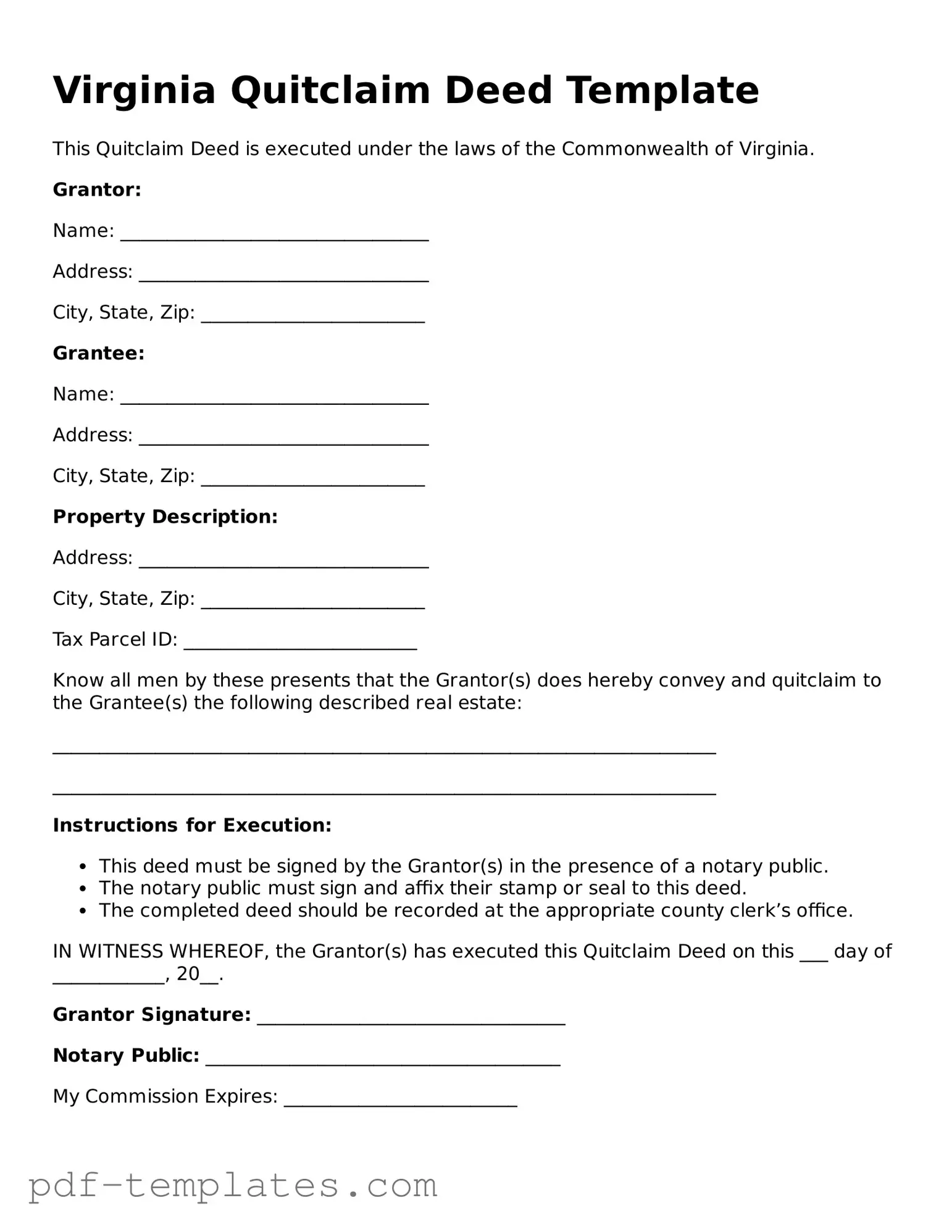The Virginia Warranty Deed is similar to the Quitclaim Deed in that both documents transfer ownership of real property. However, the Warranty Deed provides a guarantee from the seller that they hold clear title to the property and have the right to sell it. This means that if any legal issues arise regarding the title, the seller is responsible for resolving them. In contrast, the Quitclaim Deed does not offer any such guarantees, making it a more straightforward but riskier option for buyers.
The Virginia Bargain and Sale Deed also shares similarities with the Quitclaim Deed. Both documents facilitate the transfer of property ownership without providing warranties. However, the Bargain and Sale Deed implies that the seller has some interest in the property but does not guarantee that the title is free from defects. Buyers may find this type of deed more reassuring than a Quitclaim Deed, but it still lacks the full protection of a Warranty Deed.
The Special Purpose Deed is another document that resembles the Quitclaim Deed. This type of deed is often used in specific situations, such as transferring property between family members or in divorce settlements. Like the Quitclaim Deed, it typically does not provide warranties. However, the Special Purpose Deed is tailored for unique circumstances, making it a more specialized option for certain transactions.
The Virginia Deed of Trust is similar in that it involves the transfer of property rights, but it serves a different purpose. This document is primarily used to secure a loan, where the property acts as collateral. The borrower transfers the property to a trustee, who holds it until the loan is paid off. Unlike the Quitclaim Deed, which transfers ownership outright, a Deed of Trust retains certain rights for the borrower until they fulfill their obligations.
The Grant Deed is another document that has similarities to the Quitclaim Deed. Both facilitate the transfer of property ownership, but the Grant Deed includes implied warranties that the seller has not transferred the property to anyone else and that the property is free from undisclosed encumbrances. This added layer of assurance makes the Grant Deed a more secure option for buyers compared to the Quitclaim Deed.
The Trustee’s Deed operates in a manner similar to the Quitclaim Deed but is used specifically in the context of foreclosures. When a property is sold at a foreclosure auction, the Trustee’s Deed transfers ownership from the trustee to the new buyer. Like the Quitclaim Deed, it does not provide warranties regarding the title, making it essential for buyers to conduct thorough due diligence before proceeding with the purchase.
For those looking to apply for a position at Trader Joe's, it's essential to complete the Trader Joe's application form accurately, as it serves as a critical component of the hiring process. This vital document enables job seekers to present their skills and experiences effectively, thereby increasing their chances of securing employment at one of their locations. For further information, you can access the application form here: https://documentonline.org/blank-trader-joe-s-application.
The Affidavit of Heirship is another document that can relate to property transfers, although it serves a different function. This document is used to establish the heirs of a deceased property owner and can facilitate the transfer of property without going through probate. While it does not directly transfer ownership like a Quitclaim Deed, it plays a crucial role in determining who has the right to inherit and manage the property.
The Bill of Sale is similar in that it is used to transfer ownership, but it typically pertains to personal property rather than real estate. This document outlines the terms of the sale and provides proof of the transaction. While a Quitclaim Deed focuses on real property, a Bill of Sale serves a similar purpose for items such as vehicles, equipment, or other tangible assets.
The Lease Agreement shares some similarities with the Quitclaim Deed in terms of property rights, but it does not transfer ownership. Instead, a Lease Agreement grants a tenant the right to occupy and use a property for a specified period in exchange for rent. While the Quitclaim Deed conveys full ownership rights, a Lease Agreement establishes a temporary arrangement without altering the ownership status.
Finally, the Easement Agreement can be likened to the Quitclaim Deed in that it involves property rights. An Easement grants one party the right to use another party's property for a specific purpose, such as access to a roadway or utility lines. While the Quitclaim Deed transfers ownership, an Easement Agreement allows for shared use without transferring title, highlighting the nuances in property rights management.
